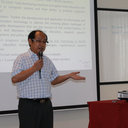Nepeta angustifolia attenuates responses to vascular inflammation in high glucose-induced human umbilical vein endothelial cells through heme oxygenase-1 induction.
Kľúčové slová
Abstrakt
BACKGROUND
The traditional folk medicine Nepeta angustifolia C. Y. Wu (NA) reportedly possesses various biological activities, such as anti-inflammatory, analgesic, antihypoxia, and antifatigue effects. In this study, we evaluated the anti-vascular inflammation effects of N. angustifolia extract in human umbilical vein endothelial cells (HUVECs) induced by high glucose (HG) as well as the underlying mechanisms and verified its activity in diabetic rats.
METHODS
HUVECs were exposed to 25 mM glucose to induce endothelial dysfunction. Adhesion molecule expression and reactive oxygen species (ROS) were assayed. IκB and IκB phosphorylation, nuclear factor-κB (NF-κB), HO-1 and nuclear factor erythroid 2-related factor 2 (Nrf2) were examined by Western blot. Nuclear localisation of Nrf2 was also examined using immunofluorescence. The in vivo study of NA was tested in diabetic rats in which the thoracic aorta and serum were collected to observe aorta histological change, and evaluate endothelial function and vascular inflammation.
RESULTS
The results revealed that HG can significantly promote the generation of ROS, the expression of cell adhesion molecules (CAMs), and the phosphorylation and degradation of IκB and NF-κB activation in HUVECs. These HG-induced phenomena were suppressed by NA-induced heme oxygenase (HO)- 1 expression in a dose- and time-dependent manner by activating Nrf2. The HO-1 inhibitor tin protoporphyrin also dramatically reversed the NA-induced inhibition of CAM expression and the reduction in ROS production. Furthermore, NA also elicited anti-vascular dysfunction effects in diabetic rats, where endothelial function was improved and vascular inflammation was alleviated.
CONCLUSIONS
All these findings indicated that NA attenuated high glucose-induced vascular dysfunction in vitro and in vivo.


